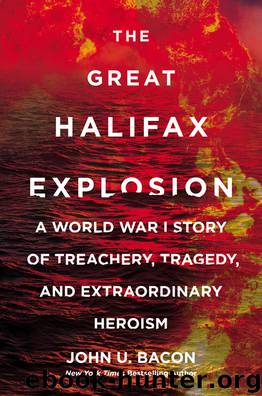The Great Halifax Explosion by John U. Bacon

Author:John U. Bacon
Language: eng
Format: epub
Publisher: HarperCollins
Published: 2017-10-04T04:00:00+00:00
PART VI
HELP
Chapter 23
No Time to Explain
The explosion instantly established Halifax as one of North America’s worst disasters, putting it on a short list with the Great Chicago Fire of 1871, the Johnstown Flood of 1889, the Galveston hurricane of 1900, and the Great San Francisco Earthquake of 1906.
The Great Chicago Fire consumed 2,000 acres, destroyed some 17,500 buildings, and left a third of the city’s 300,000 residents homeless, killing 300. But thanks to strong leadership and visionary planners, Chicago came back stronger than before, confirmed by the 1893 World’s Fair, which attracted 21 million visitors.
In 1889 in Johnstown, Pennsylvania, several days of heavy rain brought tragedy when the dam at Lake Conemaugh finally broke, sending a gigantic wave of water and smashed houses hurtling toward the blue-collar town below, killing more than 2,000 people. When some victims sued the country club where the Carnegies, Mellons, and other local millionaires vacationed, which owned the faulty dam, the courts ruled it was “an act of God.”
By the turn of the twentieth century, Galveston, Texas, had been the state’s biggest city in three of its first five decades. But after a 1900 hurricane killed a third of the 38,000 residents, the deadliest natural disaster in U.S. history, Galveston never recovered, ceding its throne to the upstart Port of Houston.
Six years later, in 1906, the people of San Francisco were awakened at 5:12 a.m. when a massive earthquake ripped the earth open from Oregon to L.A., swallowing thousands of San Francisco’s buildings, rupturing water pipes and gas lines, and lighting fires across the city. The quake left 200,000 homeless and 3,000 dead. In the immediate aftermath, Oakland’s population doubled, but San Francisco’s rebuilding program caused an economic boom and lured its residents back, and then some.
Four very different events—a fire, a flood, a hurricane, and an earthquake—created four very different disasters, with a lot in common: poor preparation usually coupled with a natural disaster, resulting in massive destruction of property, infrastructure, and human life. How the cities emerged afterward depended almost entirely on the quality of their leadership, community spirit, and a little luck.
On that basis, Chicago and San Francisco engineered the most robust recoveries. Even Johnstown’s population tripled after the flood, and didn’t start its long descent until heavy industry faded and the town suffered its third major flood in 1977. But Galveston never recovered, dropping from leader to footnote. Still, it responded better than Vanport, Oregon, a city constructed to house workers for the World War II effort. It was briefly Oregon’s second-largest city, with 50,000 people, until a broken dam wiped out all of its homes in 1948. The citizens never bothered to rebuild it, which is why you’ve probably never heard of Vanport, Oregon.
Halifax’s losses of land, property, and lives put it squarely in the middle of this pack. Its disaster was entirely man-made, but its fate would depend on the same factors that determined the future for its peers: leadership, community spirit, and a little bit of luck.
Survivors often suffered from shock.
Download
This site does not store any files on its server. We only index and link to content provided by other sites. Please contact the content providers to delete copyright contents if any and email us, we'll remove relevant links or contents immediately.
| Automotive | Engineering |
| Transportation |
Small Unmanned Fixed-wing Aircraft Design by Andrew J. Keane Andras Sobester James P. Scanlan & András Sóbester & James P. Scanlan(32170)
Navigation and Map Reading by K Andrew(4583)
Endurance: Shackleton's Incredible Voyage by Alfred Lansing(3891)
Wild Ride by Adam Lashinsky(1673)
And the Band Played On by Randy Shilts(1652)
The Box by Marc Levinson(1621)
Top 10 Prague (EYEWITNESS TOP 10 TRAVEL GUIDES) by DK(1592)
The Race for Hitler's X-Planes: Britain's 1945 Mission to Capture Secret Luftwaffe Technology by John Christopher(1543)
The One Percenter Encyclopedia by Bill Hayes(1485)
Girls Auto Clinic Glove Box Guide by Patrice Banks(1385)
Trans-Siberian Railway by Lonely Planet(1370)
Looking for a Ship by John McPhee(1339)
Fighting Hitler's Jets: The Extraordinary Story of the American Airmen Who Beat the Luftwaffe and Defeated Nazi Germany by Robert F. Dorr(1319)
Batavia's Graveyard by Mike Dash(1317)
Troubleshooting and Repair of Diesel Engines by Paul Dempsey(1301)
Bligh by Rob Mundle(1293)
TWA 800 by Jack Cashill(1269)
The Great Halifax Explosion by John U. Bacon(1252)
Ticket to Ride by Tom Chesshyre(1246)
